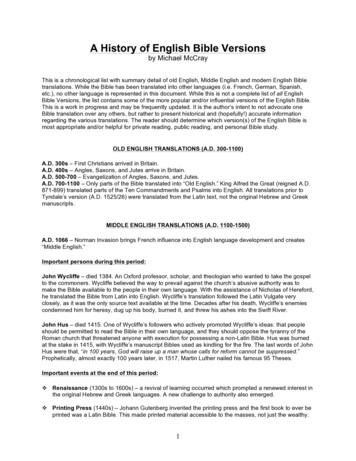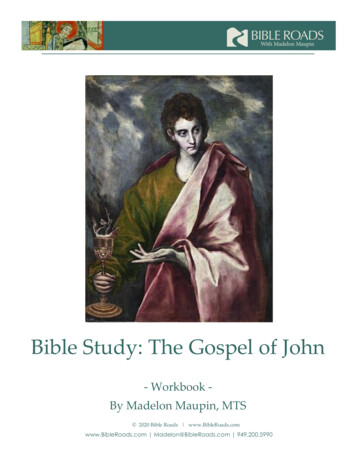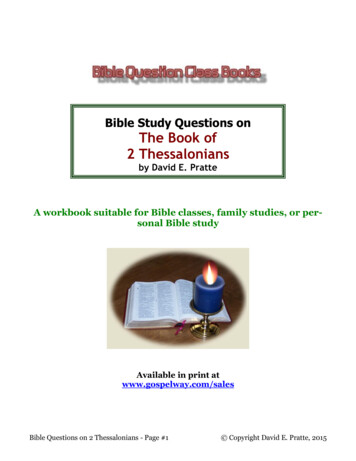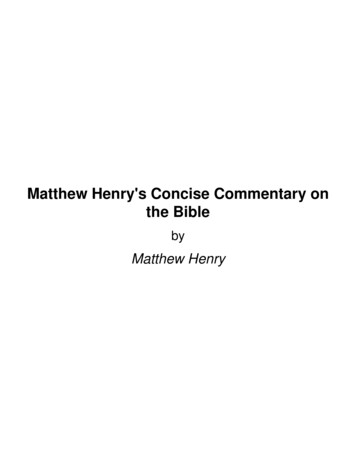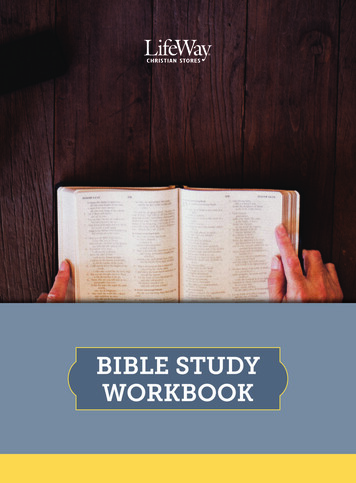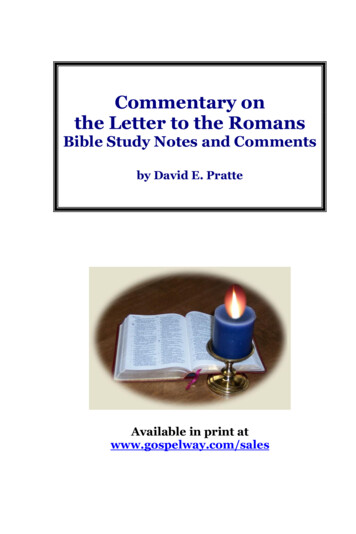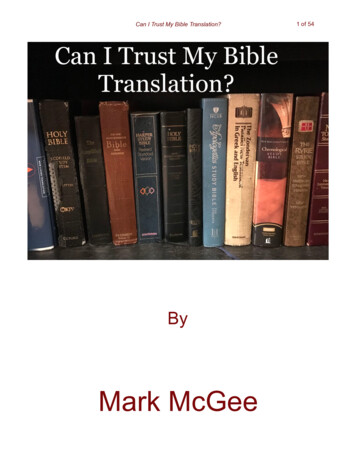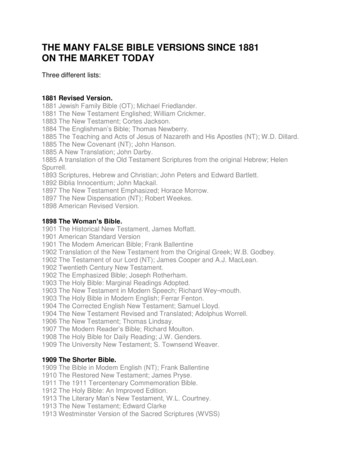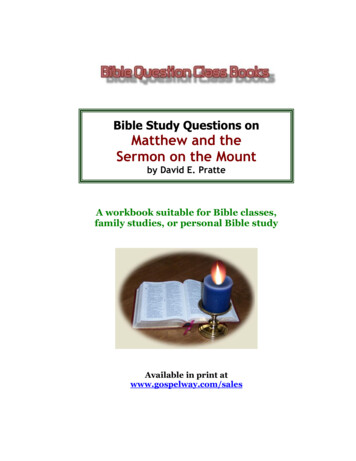
Transcription
Bible Study Questions onMatthew and theSermon on the Mountby David E. PratteA workbook suitable for Bible classes,family studies, or personal Bible studyAvailable in print atwww.gospelway.com/sales
Bible Study Questions on Matthew and the Sermon on the MountA workbook suitable for Bible classes, family studies,or personal Bible study Copyright David E. Pratte, 2016All rights reservedISBN-13: 978-1533089328ISBN-10: 1533089329Printed books, booklets, and tracts available atwww.gospelway.com/salesFree Bible study articles online atwww.gospelway.comFree Bible courses online atwww.biblestudylessons.comFree class books atwww.biblestudylessons.com/classbooksFree commentaries on Bible books atwww.gospelway.com/commentaryContact the author atwww.gospelway.com/commentsNote carefully: No teaching in any of our materials is intended or should ever beconstrued to justify or to in any way incite or encourage personal vengeance orphysical violence against any person.“He who glories, let him glory in the Lord”– 1 Corinthians 1:31Front Page PhotoA Tomb Like that in Which Jesus Was Buried“ there came a rich man from Arimathea, named Joseph, who himself had also become adisciple of Jesus. This man went to Pilate and asked for the body of Jesus. Then Pilatecommanded the body to be given to him. When Joseph had taken the body, he wrapped it in aclean linen cloth, and laid it in his new tomb which he had hewn out of the rock; and he rolled alarge stone against the door of the tomb.” (Matthew 27:57-60 – NKJV)Photo credit: Djampa distributed under Creative Commons GNU Free Documentation License,via Wikimedia CommonsWorkbook on MatthewPage #2
Other Books by the AuthorTopical Bible StudiesGrowing a Godly Marriage & Raising Godly ChildrenWhy Believe in God, Jesus, and the Bible? (evidences)The God of the Bible (study of the Father, Son, and Holy Spirit)Grace, Faith, and Obedience: The Gospel or Calvinism?Kingdom of Christ: Future Millennium or Present Spiritual Reign?Do Not Sin Against the Child: Abortion, Unborn Life, & the BibleTrue Words of God: Bible Inspiration and PreservationCommentaries on Bible BooksGenesisJoshua and RuthJudges1 SamuelEzra, Nehemiah, and EstherJobProverbsGospel of MarkGospel of JohnActsRomansEphesiansPhilippians and ColossiansHebrews1 & 2 PeterBible Question Class BooksGenesisJoshua and RuthJudges1 SamuelEzra, Nehemiah, and EstherJobProverbsEcclesiastesIsaiahGospel of MatthewGospel of MarkGospel of LukeGospel of JohnActsRomans1 Corinthians2 Corinthians and GalatiansEphesians and PhilippiansColossians, 1&2 Thessalonians1 & 2 Timothy, Titus, PhilemonHebrewsGeneral Epistles (James - Jude)RevelationWorkbooks with Study NotesJesus Is Lord: Workbook on the Fundamentals of the Gospel of ChristFollowing Jesus: Workbook on DiscipleshipGod’s Eternal Purpose in Christ: Workbook on the Theme of the BibleVisit our website at www.gospelway.com/sales to see a current listof books in print.Page #3Workbook on Matthew
Bible Study Questions on Matthew andthe Sermon on the MountIntroduction:This workbook was designed for Bible class study, family study, or personal study. The classbook is suitable for teens and up. The questions contain minimal human commentary, but insteadurge students to study to understand Scripture.Enough questions are included for teachers to assign as many questions as they want for eachstudy session. Studies may proceed at whatever speed and depth will best accomplish the needsof the students.Questions labeled “think” are intended to encourage students to apply what they have learned.When questions refer to a map, students should consult maps in a Bible dictionary or similarreference work or in the back of their Bibles. (Note: My abbreviation “b/c/v” means “book,chapter, and verse.”)For class instruction, I urge teachers to assign the questions as homework so students cometo class prepared. Then let class time consist of discussion that focuses on the Scripturesthemselves. Let the teacher use other Scriptures, questions, applications, and comments topromote productive discussion, not just reading the questions to see whether they were answered“correctly.” Please, do not let the class period consist primarily of the following: “Joe, will youanswer number 1?” “Sue, what about number 2?” Etc.I also urge students to emphasize the Bible teaching. Please, do not become bogged downover “What did the author mean by question #5?” My meaning is relatively unimportant. The issueis what the Bible says. Concentrate on the meaning and applications of Scripture. If a questionhelps promote Bible understanding, stay with it. If it becomes unproductive, move on.The questions are not intended just to help students understand the Scriptures. They are alsodesigned to help students learn good principles of Bible study. Good Bible study requires definingthe meaning of keywords, studying parallel passages, explaining the meaning of the text clearly,making applications, and defending the truth as well as exposing religious error. I have includedquestions to encourage students to practice all these study principles.Note that some questions on this book are more difficult and advanced. The study leader maywant to skip some questions if he/she is teaching a less advanced study.Finally, I encourage plain applications of the principles studied. God's word is written so soulsmay please God and have eternal life. Please study it with the respect and devotion it deserves!For whatever good this material achieves, to God be the glory.Bible study commentary and notes to accompany some of our workbooks areavailable at www.gospelway.com/sales David E. Pratte, June 21, 2017Workbooks, commentaries, and topical studies for sale in print atwww.gospelway.com/salesTo join our mailing list to be informed of new books or special sales, contact theauthor at www.gospelway.com/commentsWorkbook on MatthewPage #4
Assignments on Matthew 1Please read Matthew 1 (note parallels in other accounts) and answer these questions.1. Skim the book of Matthew and state its theme.2. List some things we know about the man Matthew.3. What advantages would Matthew have to qualify him to write this record?4. What subject is discussed in 1:1-17? Why is this genealogy important?5. How is Joseph described in 1:16? How does this differ from other men who are listed? Whatis the significance?6. Special Assignment: How does Matthew’s genealogy differ from Luke chapter 3? Studyvarious Bible helps and discuss possible explanations for the differences.7. What subject is discussed in 1:18-25? What was Joseph’s relationship to Mary – 1:18?8. What was unusual about Jesus’ conception according to 1:18? How was this explained toMary in Luke 1:26-38?9. How did Joseph react to this news about Mary, and what did he seek to do – 1:19? Explainwhy he would react in this way.10. How did Joseph learn the truth about Mary’s conception? What explanation was given tohim? (Think: How would this solve the concerns that Joseph had?)Page #5Workbook on Matthew
11. Special Assignment: Compare what Joseph was told here about the conception of Maryto what she herself was told in Luke chapter 1. How do the accounts compare?12. What did the angel predict about the child that had been conceived – 1:21? What namewould He be given?13. Explain the meaning of the child’s name. Why was this name appropriate?14. List other passages confirming that Jesus is the One sent by God to save men from sin.15. According to 1:22,23, what Old Testament prophecy would be fulfilled by the birth ofJesus? Where in the Old Testament is this prophecy found?16. Special Assignment: Explain why Jesus’ birth would be unusual according to thisprophecy and the context of Matthew 1. What should we learn about Jesus’ character?17. What special name would Jesus be given? What is the meaning of this name? (Think: Howwould this name accurately describe Jesus according to the teaching of the context?)18. How did Joseph react to the message he received – 1:24,25? What was the child named?19. What relationship did Joseph and Mary have, and how long did that relationship lastaccording to 1:25?20. Case Study: Some people believe that Mary remained a virgin all of her life. Explainwhat the Bible teaches about this here and elsewhere.21. Special Assignment: Summarize the evidence that Jesus was born of a virgin.Workbook on MatthewPage #6
Assignments on Matthew 2Please read Matthew 2 (note parallels in other accounts) and answer these questions.1. Where and when was Jesus born – 2:1 (see map)? Who came to Jerusalem at this time?(Think: According to Luke’s account, why was Jesus’ family in Bethlehem at this time?)2. What reason did the wise men give why they had come – 2:2?3. How did Herod react when he heard the reason for the coming of the wise men – 2:3? Whywould he be concerned in this way?4. Whom did Herod call together and what question did he ask them – 2:4,5? What answerdid they give him, and how did they know the correct answer?5. What did the prophecy say about the birth of the Christ – 2:6? Where is this prophecyfound? Why is it important that we understand the prophecy about Jesus’ birth?6. What question did Herod ask of the wise men – 2:7,8? What request did he make of them,and what reason did he give for the request?7. How did the wise men identify the place where Jesus was – 2:9,10? How did they react asa result? (Think: What can we learn about the significance of the star?)8. What did the wise men do when they found Jesus and Mary – 2:11? What gifts did theypresent? (Think: What does the story show about the character of the wise men?)9. Special Assignment: How does the Bible account compare to common tradition? Doesthe Bible state the number of wise men? Did the wise men find Jesus in a stable?10. What further information did God give to these men – 2:12? What did they do as a result?(Think: Based on the subsequent story, why did God so instruct these men?)Page #7Workbook on Matthew
11. What was Joseph told to do – 2:13? What reason was given for this instruction?12. What did Joseph do as a result – 2:14,15? How long did they stay? How did this relate toOld Testament prophecy?13. How did Herod react when the wise man did not return to him – 2:16? What did he do?14. Special Assignment: Consider the age of the boys Herod slew. Did the wise men visitimmediately after Jesus’ birth? What can we learn about Herod’s character?15. What prophecy was fulfilled by Herod’s act – 2:17,18? Where was this prophecy found?(Think: What is the significance of the reference to Rachel and to Ramah?)16. Application: How did the wise men and Herod illustrate the different reactions peoplehave to Jesus? Notice that these reactions began from the time of His birth.17. What was Joseph instructed to do – 2:19,20? Why was it safe to do this?18. What did Joseph do in response to the instruction – 2:21,22? What further informationdid he learn when they arrived in Israel? Why would this concern him?19. What instruction was he given about where to go next? So where did he take his family,and how did this relate to Old Testament prophecy (see map)?20. Special Assignment: Research Biblical helps and see what you can learn about theHerods mentioned in this chapter. Were these real men, and what kind of men were they?Workbook on MatthewPage #8
Assignments on Matthew 3Please read Matthew 3 (note parallels in other accounts) and answer these questions.1. Whose work is described beginning in 3:1? Where did he preach? According to Luke chapter1, who were his parents, and what was his relationship to Jesus?2. What was his message – 3:2? Define repentance. List other passages about it.3. Case Study: Many people believe that the kingdom of Christ will not begin till Jesuscomes again. What did John teach about the kingdom? What can we learn about the nature andexistence of the kingdom from John 18:36, Colossians 1:13,14?4. What prophecy did John’s work fulfill – 3:3? Where was this prophecy found in the OldTestament? What does this tell us about John’s purpose?5. Describe John’s clothing and food – 3:4?6. Who came to John – 3:5,6? Why? What did they do along with baptism?7. Application: Where did John baptize? What can we learn about the action involved inbaptism (see also verse 16)? List other passages showing whether baptism is sprinkling, pouring,or immersion.8. Who else came to John’s baptism, and what was his message to them – 3:7? Who were thesemen, and why would John speak to them this way?9. What did John teach in 3:8? Explain what it means, and give similar passages.10. Application: How should we describe the kind of preaching John did? Did John believethe modern idea that we should not criticize other people’s beliefs? Explain.Page #9Workbook on Matthew
11. What did John say these people might think – 3:9? How did he answer this view? (Think:How did John’s response show the error of these people?)12. What illustration did John use in 3:10? Explain the significance.13. How did John compare himself to Jesus – 3:11? How did he compare their baptisms?(Think: Study context and decide the meaning of baptism in fire – note verses 10,12.)14. Case Study: Some people claim to have Holy Spirit baptism today. List other passagesand describe characteristics of Holy Spirit baptism compared to water baptism.15. How did John illustrate the work of Jesus in 3:12? Explain the illustration.16. Who came to be baptized by John according to 3:13,14? How did John respond to him?(Think: Why would John respond in this way?)17. What response did Jesus give to John – 3:15? Explain the significance. (Think: Did Jesushave sins for which He needed to repent and be forgiven?)18. How did the Father and the Holy Spirit express their approval of Jesus – 3:16,17?19. Case Study: Some people believe the Father, Son, and Holy Spirit are just one individual.What can we learn from Jesus’ baptism that shows whether or not this idea is true?20. Special Assignment: What can we learn from this account about Jesus’ nature?21. Case Study: Some people today claim to still practice John’s baptism. Study Acts 19:1-6and discuss the Bible teaching about this belief.Workbook on MatthewPage #10
Assignments on Matthew 4Please read Matthew 4 (note parallels in other accounts) and answer these questions.1. Where did the Holy Spirit lead Jesus, and for what purpose – 4:1? What did He do when Hewas there? For how long – 4:2?2. How did Satan tempt Jesus in 4:3? Explain why this would be a temptation to Him.3. How did Jesus answer Satan – 4:4? Where is this Old Testament passage found?4. Application: What can we learn from Jesus’ answer about proper priorities? What can welearn about proper applications of God’s word?5. Where did Satan take Jesus, and what did he tempt Him to do – 4:5,6? What Old TestamentScriptures did he quote? Explain why this would have been difficult to resist.6. How did Jesus answer this temptation – 4:7? Where is this passage found in the OldTestament?7. Application: Explain why Jesus’ answer was a good response to the temptation. What canwe learn about the proper use of Scripture?8. Describe the next temptation – 4:8,9. Why would this have been difficult for Jesus?9. How did Jesus respond to this temptation – 4:10? Where is this passage found in the OldTestament? What can we learn about proper worship?10. Application: Why is the temptation of Jesus important to us? Note Hebrews 4:15. Whatlessons can we learn about resisting temptation?Page #11Workbook on Matthew
11. Where did Jesus go – 4:12,13 (see map)? What event caused Him to go there?12. What Old Testament prophecy did this fulfill – 4:14-16? Where is this passage found?13. What message did Jesus preach – 4:17? How did this compare to the preaching of Johnthe Baptist? (Think: Were Jesus and John mistaken, as some people believe, when they said thekingdom was at hand?)14. Whom did Jesus find in 4:18? What were they doing, and where did this occur?15. What instruction did He give them, and how did they respond – 4:19,20?16. Explain the significance of the illustration about fishing for men. In what way was the workJesus had for them to do like fishing?17. Who else did Jesus call – 4:21,22? What were they doing? How did they respond?18. Application: Was this the first time these men had ever learned anything about Jesus?What can we learn from their response to His call?19. Where did Jesus go and what did he do – 4:23,24? What was the result?20. Application: What kind of problems was Jesus able to heal? What can we learn from themiracles He accomplished? How do these compare to modern so-called faith healers?Workbook on MatthewPage #12
Assignments on Matthew 5Please read Matthew 5 (note parallels in other accounts) and answer these questions.1. Where did Jesus preach this sermon? Who was present – 5:1,2?2. Define “beatitude.” Why is this a good term for verses 1-12?3. Define “poor in spirit” – 5:3. List other passages about it.4. Special Assignment: List some characteristics of people who are poor in spirit. For eachone, give at least one Scripture and then explain the application to our lives.5. What blessing did Jesus pronounce on the poor in spirit? Explain this blessing, and explainhow being poor in spirit leads to it.6. Special Assignment: Contrast Jesus’ teaching here to what people typically believe.7. Jesus pronounced the second blessing on whom – 5:4? Define “mourn.” (Think: DoesJesus refer to mourning for physical reasons or for spiritual reasons? Explain.)8. Application: List and explain passages that connect mourning to repentance and/orsorrow for sin and its consequences. In what senses should we grieve about sin?9. What blessing did Jesus pronounce on those who mourn? Explain how mourning may leadto being comforted.10. Special Assignment: How does this contrast to what people usually believe?Page #13Workbook on Matthew
11. Jesus pronounced the third blessing (beatitude) on whom – 5:5? Define “meek.”12. List and explain several verses that help us understand what meekness means.13. Application: List some ways meekness shows itself in people’s lives. For each one, giveat least one passage of Scripture and then explain the application to our lives.14. What blessing did Jesus pronounce on those who are meek? Study other passages that usethe phrase “inherit the earth” (or similar phrases, especially in the Old Testament). Explain themeaning and how it relates to meekness.15. Special Assignment: How does this contrast to what people usually believe?16. Jesus pronounced the fourth blessing (beatitude) on whom – 5:6? Describe what it meansto “hunger and thirst.”17. Define “righteousness.” List and explain several verses that help us understand whatrighteousness means.18. Application: List some ways hunger and thirst for righteousness shows itself in people’slives. For each one, give other Scripture and then explain the application to our lives.19. What blessing did Jesus pronounce on those who hunger and thirst for righteousness? Listseveral specific blessings that one who truly hungers and thirsts for righteousness will receive.Explain how hungering and thirsting for righteousness can lead to these blessings.20. Special Assignment: How does this contrast to what people usually believe?Workbook on MatthewPage #14
21. Jesus pronounced the fifth blessing (beatitude) on whom – 5:7? Define “mercy.”22. List several verses that help us understand mercy. (Think: Does mercy mean we overlookpeople’s sins or give whatever people ask or do whatever they ask us to do?)23. Application: Explain how mercy should affect our lives in each area below. For each one,try to find at least one passage of Scripture and then explain the application to our lives.a) Helping people with physical needs b) Forgiving others as God forgives us c) Teaching the gospel to the lost 24. What blessing did Jesus pronounce on the merciful? Explain how showing mercy to otherscan lead to this blessing.25. Special Assignment: How does this contrast to what people usually believe?26. Jesus pronounced the sixth blessing (beatitude) on whom – 5:8? Define “pure.” (Think:To what does the “heart” refer in such verses as this?)27. List and explain verses that help us understand what it means to be pure in heart.28. Application: List some lessons purity of heart will teach us. For each one, try to find atleast one passage of Scripture and then explain the application to our lives.29. What blessing did Jesus pronounce on the pure in heart? Explain how being pure in heartcan lead to this blessing.30. Special Assignment: How does this contrast to what people usually believe?Page #15Workbook on Matthew
31. Jesus pronounced the seventh blessing on whom – 5:9? Define “peace.”32. List and explain several verses that help us understand the meaning of peace.33. Application: List relationships in which we should seek peace. For each one, find at leastone passage and explain how we can be peacemakers in that relationship. (Think: What limitsdoes the Bible place on peace? Should we seek peace at any price without limit?)34. What blessing did Jesus pronounce on the peacemakers? Explain how being peacemakerscan lead to this blessing.35. Special Assignment: How does this teaching contrast to what people usually believe?36. Jesus pronounced the eighth blessing (beatitude) on whom – 5:10-12? Define“persecute” and “revile.”37. List and explain several verses that describe persecution. What is the difference betweenpersecution that is blessed and punishment for evil?38. Application: List some ways people try to pressure good people to do wrong. Describesome Bible teachings about how we should deal with persecution. Give passages.39. What blessing did Jesus pronounce on those who are persecuted? (Think: Many peopledeny that heaven will be the eternal reward of Christians. What does this passage teach?)40. Special Assignment: How does this contrast to what people usually believe?Workbook on MatthewPage #16
41. State in your own words the theme of 5:13-16. List three examples Jesus uses to illustrateHis point. Explain how each example relates to the theme.42. Application: What should we learn from a city set on a hill cannot be hidden?43. What did Jesus mean by salt losing its saltiness or a light being hid under a bushel?44. Special Assignment: Explain what application Jesus’ teaching would have in ourrelationships with various specific groups of people.45. Application: Explain ways disciples can fail to be an influence for good. Give examples.Discuss problems caused when people who profess to serve God don’t live a good life.46. What does 5:16 say leads people to glorify God? Explain how our influence, good or bad,reflects on the Father. Give Scriptures.47. What subject did Jesus introduce in verses 17,18? What did He say about the law?48. Case Study: Many people use this passage to argue that Jesus did not remove the law,so it must still be in effect. Give other passages about our relationship to the Old Law.49. What is meant by a “jot” and a “tittle”? Give examples of what would still be in effect, ifevery jot and tittle still remains today.50. What did Jesus actually say in 5:18 about when the law would “pass away”? What did Hesay He came to do (5:17)? If He did what He came to do, what would happen to the law? (Think:Compare 5:18 to Luke 16:17. Explain the expression “till heaven and earth pass away.”)Page #17Workbook on Matthew
51. List and explain passages showing whether or not Jesus fulfilled the law. If Jesus fulfilledthe law, then what has happened to it? (Think: In what sense did He not “destroy” it?)52. Explain why Jesus encouraged people to teach and do the commandments – 5:19. (Hint:Was the law still in effect when He spoke here? When was it removed?)53. Special Assignment: How should our righteousness compare to that of scribes andPharisees – 5:20? Explain ways in which the righteousness of these people was lacking.54. Special Thought questions: In subsequent verses, Jesus repeatedly contrasts Histeaching to past teachings. As we study, consider the following general questions: (1) To what priorteachings does Jesus refer: The Old Testament law, human traditions about the law, both, orneither? (2) How literal and specific did Jesus intend these teachings to be?55. What prior teaching does Jesus discuss beginning in 5:21? Try to find passages wheresuch was taught.56. What did Jesus teach about anger (5:22)? Why discuss anger in the context of murder?57. Application: Does a person sin every time he is angry with his brother? Explain and giveexamples of anger that is sinful as compared to anger that may not be sinful.58. List and explain other passages that show why anger is dangerous.59. Define the terms “raca” and “fool.” What consequences would follow from using theseexpressions? (Think: Do people in other passages call people a “fool” without sinning?)60. Application: Did Jesus intend here to remove specific code words from our vocabulary,or is there a deeper meaning to His teaching? Explain and prove your answer.Workbook on MatthewPage #18
61. Define “reconcile” – 5:24. What must we do if a brother has something against us?62. How did Jesus emphasize the importance of this duty – 5:23?63. What are the duties of one who believes a brother has sinned against him? List otherpassages that discuss our duty when we have something against one another.64. Case Study: Alienated brethren often think, “It’s his fault. He should come to me.” Or“There is nothing that can be done about it.” Summarize the Bible teaching about reconciliationbetween disciples. Are we justified in allowing alienation to continue?65. What did Jesus say we should do when an adversary may take us to the judge – 5:25,26?What consequences may follow if we don’t take this action? (Think: What does this teachingassume about our guilt? Should we admit guilt when we are innocent?)66. Application: Rather than admit their errors and seek to correct them with those whohave been harmed, what do many people try to do?67. What prior teaching does Jesus discuss beginning in 5:27? Try to list passages wheresuch was taught.68. What teaching did Jesus give in contrast – 5:28? Define “lust” and “adultery.”69. List and explain other passages that teach ideas related to what Jesus taught here. Whyare the thoughts in a person’s heart important? How might thoughts relate to adultery?70. Application: Explain in your own words the principle Jesus taught and give applicationsthat illustrate the point.Page #19Workbook on Matthew
71. Summarize what Jesus taught in 5:29,30. How does this relate to adultery?72. Special Assignment: Did Jesus mean for us to literally practice what He specificallystates in verses 29,30? Prove your answer by Scripture.73. Application: Explain the point of 5:29,30 and give practical applications.74. What previous teaching does Jesus discuss beginning in 5:31? Where was this taught, andwhat did the teaching say?75. In contrast to the older teaching, what did Jesus teach – 5:32? Define “divorce,”“fornication,” and “adultery.”76. List and summarize other passages that relate to this topic. (Think: Is Jesus teachingdifferently from the Old Law, or is He correcting misunderstandings of the law? Proof?)77. In what sense would a man, if he divorced his wife without Scriptural grounds, “cause herto commit adultery?” What is the condition of the man who marries the woman?78. Application: Is Jesus saying divorce itself is wrong (if not for fornication), or only thatthe remarriage is wrong? I.e., may a man divorce, as long as he does not remarry? Proof?79. What is the permissible reason for divorce? (Think: May a person remarry if he was putaway because he committed fornication? Explain.)80. Application: What must a person do if he/she is in an adulterous marriage because of adivorce for a cause other than fornication? Prove your answer.Workbook on MatthewPage #20
81. What previous teaching does Jesus discuss beginning in 5:33? Was this concept directlytaught in the Old Testament? List passages that are similar in meaning.82. Define “swear” and “oath.”83. Special Assignment: Is swearing the same as cursing or profanity? Explain.84. Note Matthew 23:16-22. What traditions had the Jews built up about swearing?85. List and explain other passages about swearing or oaths.86. In contrast to the older teaching, what did Jesus teach – 5:34-37?87. Application: Can you find New Testament passages in which anyone swore or took anoath or the equivalent with God’s approval? Explain the lessons Jesus meant for us to learn. Listand discuss some applications.88. What previous teaching did Jesus discuss in 5:38? List Old Testament passagesregarding it. What was the meaning of those passages?89. What did Jesus teach in contrast to the former teaching – 5:39-41? List and explain otherpassages that help us understand Jesus’ teaching.90. Special Assignment: How literally did Jesus intend this teaching to be taken? Whatdid He do when He was slapped or attacked? What did other disciples do when attacked? Explainwhat applications we should make of 5:39.Page #21Workbook on Matthew
91. What further examples did Jesus give in 5:40,41? Again, how literally did Jesus intend thisteaching to be applied? What applications should we make?92. How is the principle stated in 5:42? Again, how literally should this be taken? What is theproper application? Are there limits on the teaching?93. What previous teaching did Jesus discuss in 5:43? Were these teachings included in theOld Testament? List and explain relevant Old Testament passages.94. How did Jesus say we should treat those who mistreat us – 5:44?95. Application: List and explain other related New Testament passages. Explain thelessons we should learn for our own lives. How should we apply these principles?96. How does the conduct of God illustrate the principle Jesus is teaching – 5:45?97. How does Jesus’ teaching compare to wha
Bible Study Questions on Matthew and the Sermon on the Mount Introduction: This workbook was designed for Bible class study, family study, or personal study. The class book is suitable for teens and up. The questions contain minimal human commentary, but instead urge st
